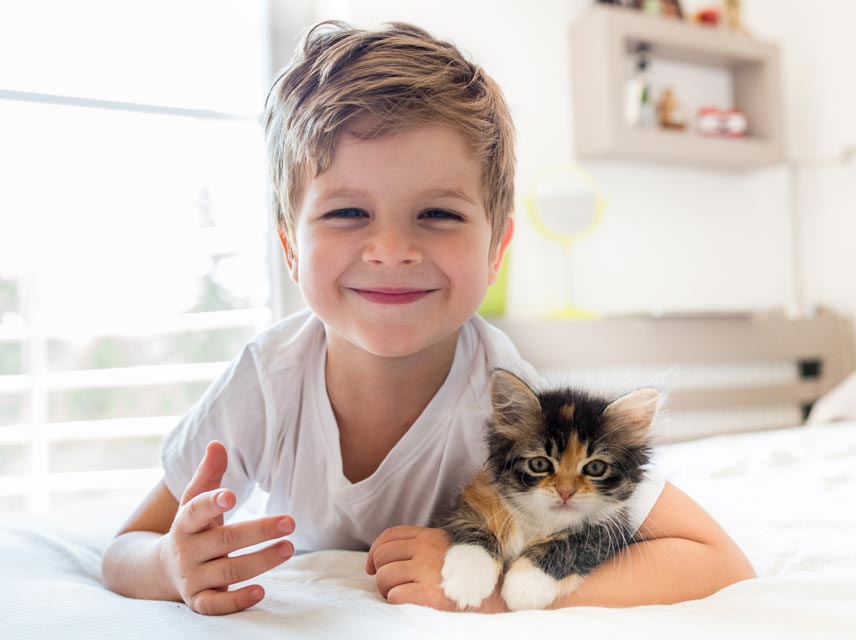How to Teach Kids How to Behave with Cats

When cats and kids live in the same house, it's necessary to have some rules, and kids need to be taught what is and is not appropriate behavior around feline friends. Here, we've compiled some basic rules that should be enforced between kids and cats and information on how to do so in your home.
Always Supervise Cat-Kid Interactions
When your child is small, all interactions with cats should be supervised. Don't leave your young child alone with a kitty, and be sure you're close enough to intervene if your child is being rough or the cat is indicating that she might bite or scratch.
If your child (or you) is ever bitten or scratched by a cat, wash the wound out with soap and warm water and then visit the doctor immediately. Don't wait. Cat bites and scratches are notorious for becoming infected, and they can be quite serious. Infection seeds and spreads quickly and aggressively.
If the Kitty Walks Away, Don't Chase
Kids should be taught right away that a cat that disengages from a playing or petting session by walking or running away should never be followed, chased, or pestered. A cat that is moving away is indicating politely that she'd like a little space at the moment, and continuing to force engagement could result in her scratching or biting.
Be sure to provide your cat with safe spots that she can go to get away from the child. She will probably appreciate these the most if they are up high, where she can go to watch what the child is doing but not have a need to engage if she doesn't wish to. Some ideas are tall cat scratching posts with perches on top or high shelves that have been cleared off (and are bolted to the wall for stability). Cat caves are also great for providing a hiding spot from which a cat can feel unseen herself but still see what's going on. You should teach your child that interacting with the cat while she is in these spots is not allowed, and give reminders whenever necessary.
Do Not Disturb a Cat in a Litter Box
Cats need to have a litter box in a spot where they won't be bothered by loud noises, dogs, or kids. If a cat is harassed or scared while using the box, there is a high probability that she will become averse to using it, and that can lead to inappropriate elimination.
Teach your children that, when your cat heads to the litter box, they are not to follow or interact with her while she's in there. You may also wish to use a baby gate that your cat can jump over to block off the room or area where the box sits, just as a visual reminder for your child not to follow the kitty in there.
Be Gentle
The number one rule for a child's interaction with a cat is that gentleness should always be used. Hitting, fur or tail-pulling, and rough handling should all be banned. Most of the time, young children should not be allowed to carry the cat until they are old enough to learn how to do so properly, by supporting the cat's underbody and rear end.
Avoid the Tummy, Tail, Ears, and Paws
Kids should be taught the areas of the body that many cats dislike having touched. These include the ears, tail, belly, and paws. Even if your cat doesn't mind having those spots handled, it's important to teach them to your child in case a different cat is encountered. When you are teaching your child how to behave around cats, you are doing so for all cats, not just the ones that might live in your home at the time. These are skills that your child will be able to use at others' homes and throughout life.
Begin Teaching Feline Body Language Cues
It's never too early to start helping your child notice and understand cat body language. You can do so by keeping up a running narrative while your child and cat interact. You can say things like, "Kit-Kat is purring, her face looks relaxed, and her eyes are half-closed. She is enjoying your petting," and "Stop doing what you're doing right now because Kit-Kat's angry and might bite or scratch you. I can tell because her tail is jerking quickly back and forth, and her muscles look tense."
Train the Cat, Too
You should use positive reinforcement to train your cat to get along well with your child, too. Praise her and give her treats for good, tolerant behavior with your child. Don't yell at her if she is irritated, though; just give her some space and have your child do so, as well. Some cats are more naturally tolerant of children than others. If your cat is not particularly social around kids, go slowly, giving praise when she is calm and does well. Never force your cat to interact with your child.
You May Also Like These Articles:
How to Ease Introductions Between Dogs and Cats
Why Cat Bites Should Always Be Taken Seriously
Why Do Cats Love Small Spaces?


